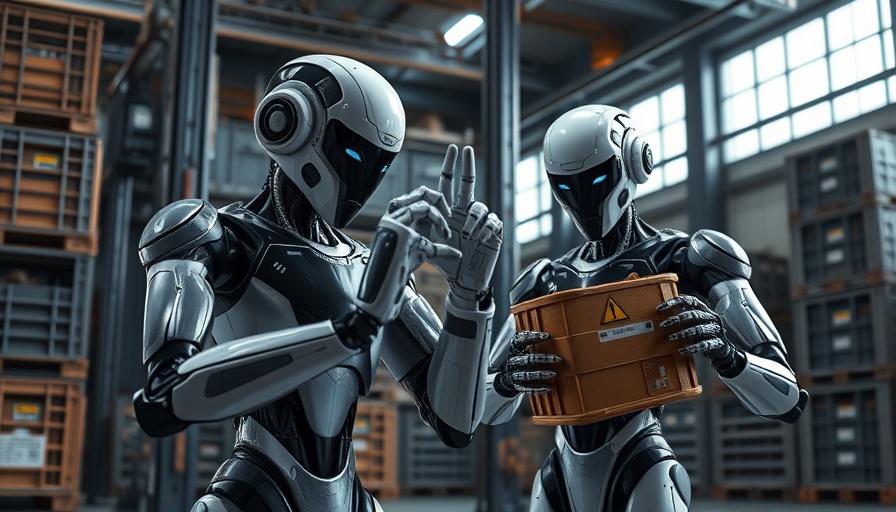
The Future of Humanoid Robots: An Exciting Evolution
Boston Dynamics has recently taken a monumental leap forward with its humanoid robot Atlas, which has undergone a significant upgrade with the implementation of a large behavior model (LBM). This revolutionary approach transforms how robots learn and operate, focusing on skill acquisition through demonstrations rather than tedious coding of movements. In this context, Atlas has shown remarkable capabilities—from seamlessly performing complex sequences of tasks to executing adjustments on the fly when faced with unexpected challenges. The implications for both the field of robotics and potential applications in various industries are vast.
In the video 'Boston Dynamics ATLAS Just Got a Huge Brain Upgrade + Unitree’s New Flagship Robot,' the discussion dives into remarkable advancements in humanoid robotics, exploring key insights that sparked deeper analysis on our end.
Unifying Control for Enhanced Dexterity
One of the standout features of the LBM is that it allows for a unified control of the entire robot system. Instead of splitting responsibilities between separate locomotion and manipulation controls, the robot now operates as a cohesive unit. This means that Atlas can treat hands and feet similarly, enhancing its ability to solve problems naturally and respond adeptly to varied scenarios. As the vice president of robotics research at Boston Dynamics, Scott Quindersma, asserted, this integration opens new doors for robots to function effectively in human environments—an essential requirement as we transition towards greater robotic automation in our daily lives.
Competing in the Humanoid Race: Unitree's Ambitions
While Boston Dynamics strengthens its foothold in humanoid robotics, China's Unitree is not far behind. The company is set to introduce a new humanoid robot, standing at 180 cm tall, equipped with 31 degrees of freedom in its joints. Such flexibility is crucial for tasks requiring intricate movements, like comfortable walking and manipulation. Unitree's aggressive pursuit of humanoid technology suggests a serious commitment to capturing a leading position in this burgeoning market, raising the stakes in the race for humanoids.
Figure’s Cutting-Edge Reinforcement Learning
Meanwhile, the startup Figure has made significant strides with its humanoid model that showcases an astonishing walking controller known as Helix. The controlling system allows their robots to navigate through obstacles with astounding efficiency, even in blind conditions—demonstrating reliance solely on motor sensors for balance and movement. This method, grounded in reinforcement learning, facilitates constant improvement through each trial, which could establish Figure's robots at the forefront of humanoid design, particularly when tackling real-world environments.
South Korea's Alex: Merging Strength and Finesse
Emerging innovation is also coming from South Korea with the introduction of Alex, a humanoid robot that prioritizes muscle-like precision and responsive control. Unlike many traditional heavy robots, Alex utilizes advanced mechanics to deliver delicate yet powerful movements, making it particularly suited for sensitive environments, such as healthcare and elder care. Designed to operate collaboratively with humans, Alex represents a unique blend of agility and durability.
Innovative Technology at Techman Robot
Techman Robot is another player in this dynamic field with its humanoid robot TM Explore II, powered by Nvidia’s advanced AI and edge computing technologies. Although it deviates from traditional bipedal designs by utilizing wheels, its human-like actions enhance its functional versatility. As it gears up for internal testing, Techman’s foray into humanoid robotics echoes the larger trend of integrating AI capabilities into mechanical forms.
The Economic Implications of Humanoid Robotics
The continuous improvements in humanoid robots hint at wider economic implications. As these machines become more intertwined with everyday activities, the potential for productivity increases is immense. However, the rise of such technologies also ushers in challenges related to workforce displacement, safety regulations, and ethical considerations surrounding human-robot interactions. These complexities warrant careful scrutiny as companies push the boundaries of robotics in pursuit of efficiency.
Keeping an Eye on Humanoid Developments
The evolution of humanoid robotics encapsulated in the developments from Boston Dynamics, Unitree, Figure, and Techman signifies a rapidly maturing field cognizant of its potential impacts on society. With ongoing advancements in AI, we stand on the precipice of a future where humanoid robots can perform an array of tasks, creating opportunities—and challenges—for human counterparts. Keeping abreast of these developments not only enriches our understanding of technology but also sparks important conversations about the role of robotics in our future.
 Add Row
Add Row  Add
Add 




Write A Comment